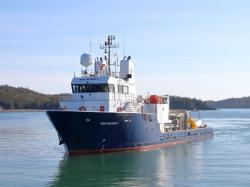Cooke Aquaculture Launching New “Green” Technology In Atlantic Canada
April 26, 2018 | 3 min to read

BLACKS HARBOUR, NB – Blacks Harbour-based Cooke Aquaculture has added a new vessel to its fleet that will use warm-water baths to address sea lice. It’s the first time that this Norwegian technology is being used in Atlantic Canada to combat sea lice. The adoption of Thermolicer™ technology is part of the company’s continued investment in innovative, chemical-free sea lice management tools.
“Trialed last summer, this technique has proven to be 98 per cent effective at removing the lice without harming the fish. It’s a simple and effective treatment that further reduces our need to use chemicals or medicines. This is an exciting evolution in sea lice management for us,” said Joel Richardson, Vice President, Public Relations for Cooke Aquaculture.
Cooke Aquaculture has invested millions of dollars in research, development and engineering to build a complement of green sea lice treatment options that don’t involve chemical baths or in-feed treatments. Several options – including some developed in-house and some that have been designed by industry-leading companies – have shown tremendous promise. Provincial and federal governments have also supported research and development of alternative sea lice treatments methods.
The Norwegian-engineered system called a Thermolicer™ – a warm-water based sea lice removal system uses a warm water bath to gently remove sea lice without damaging or causing stress to the fish. Steinsvik, a leading technology supplier to the global aquaculture industry, developed and produced The Thermolicer™. Cooke has recently brought into service the Miss Mildred, a marine vessel equipped with Thermolicer™ technology.
“The Thermolicer™ exploits a vulnerability of sea lice that we know do not tolerate sudden changes in water temperature. Sea lice are immediately sensitive to sudden temperature changes. By suddenly heating the lice, it will fall off the fish,” said Steinsvik’s Marketing Representative, Tore Laastad.
“Sea lice are naturally-occurring in the marine environment and can affect both wild and farm-raised fish. They do present a fish health challenge for our sector and for many years our company, and in fact the industry worldwide, has pursued effective, environmentally-sound treatment methods,” said Richardson.
The fish are transferred from the pen and separated from the seawater before they enter the Thermolicer™. Each fish moves through the Thermolicer™ in 30 seconds. All lice removed in the system are filtered and safely composted at approved, land-based waste management facilities.
While the Thermolicer™ is a promising development to mitigate sea lice, it’s not the only environmentally-friendly innovation in development at Cooke Aquaculture. Two other systems are expected to be deployed this summer; the in-house designed “Cooke R”, that has been extensively trialed, and the “Hydrolicer” which uses water pressure to remove sea lice. Each of these mechanical sea lice removal tools are effective and environmentally responsible.
“Farmed salmon is one of this region's biggest economic drivers and exports. Atlantic Canada’s locally owned and operated fish farms produce 50 per cent of the country’s farmed salmon,” Richardson said. “We have so much to be proud of as an industry – our people, our sector's sustainable and responsible growth and the healthy salmon we produce. The salmon farming industry has revitalized coastal communities and supported thousands of goods and services suppliers from inland municipalities, towns and villages.”
Source: Cooke Aquaculture
